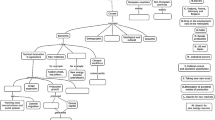Abstract
The purpose of this article is to explore student-generated connections among counting problems. The literature indicates that such problems pose difficulties for students, who struggle to detect common structures and identify models of underlying problem types. A case study is presented here, in which students elaborate upon connections they make during the problem solving process. The selected case study highlights student work on three particular combinatorics problems, one of which highlights tendencies toward over-counting. The conception of Lobato (Educational Researcher 3(1):17–20, 2003) of actor-oriented transfer, in which students’ (as opposed to experts’) notions of similarity are emphasized, is used as a means by which to analyze the resulting qualitative data. Results include (1) a domain-specific categorization of fundamental types of actor-oriented transfer in combinatorics and (2) implications that there is much to be gained when students attend to features of problems that experts might not emphasize.




Similar content being viewed by others
Notes
There are further categorizations of problems which are established in much the same way. Stanley (1997) and Bona (2007) both suggest a 12-fold way of categorizing problems. Stanley re-casts the problems in terms of functions that are or are not injective, surjective, or bijective. Bona makes a similar case for the 12-fold way, although his argument re-conceptualizes counting problems in terms of distributing balls into boxes; the problems change depending on whether the balls are identical, the boxes are identical, and whether there are constraints on the number of balls in the boxes. Throughout combinatorics textbooks, then, what essentially emerge are tables of prototypes of different ways that a counting problem may be modeled.
The combinatorics class was designed for senior undergraduates and first-year graduate students at a large urban university; topics included counting techniques, recurrence relations, generating functions, and combinatorial proof. It is “advanced” because it follows a discrete mathematics course, which is a junior-level course that offers an introduction to combinatorial topics.
How many arrangements of the word GRACEFUL have no consecutive vowels?
The Donut problem: How many ways are there to fill a box with a dozen donuts chosen from five varieties? The Donut problem can be categorized as a selection with repetition problem. The solution to this problem is typically solved using a method referred to by some as “stars and bars” (e.g., Richmond & Richmond, 2004), so named because of the particularly clever model that the solution employs. The particular solution models the problem as a menu in which the five donut varieties are listed as column headings. To indicate that a donut of a particular kind is chosen, the counter would place an x (a star) in that variety’s column. Thus, selecting 12 donuts becomes a matter of placing 12 x’s among the five columns. The five columns themselves are separated by four bars, and when looked at in a certain way, the problem essentially becomes a matter of arranging four identical bars and 12 identical stars.
There are multiple ways of expressing the solutions to each problem, many of which elicit a different counting technique. However, the solutions elaborated upon in this section are most relevant to what the students actually did and to the discussion at hand.
Combinatorial methods yield the following solution, where each term represents the case of one-letter through six-letter words, respectively: 4 + (2 + 12) + (24 + 18) + (6 + 72 + 24) + (60 + 120) + 180. Each case is further broken into cases based on the number of repeated letters in each word.
This is the case where the number must start with a 6.
References
Barnett, S. M. & Ceci, S. J. (2002). When and where do we apply what we learn?: A taxonomy for far transfer. Psychological Bulletin, 128(4), 612–637
Batanero, C., Navarro-Pelayo, V., & Godino, J. (1997). Effect of the implicit combinatorial model on combinatorial reasoning in secondary school pupils. Educational Studies in Mathematics, 32, 181–199.
Bona, M. (2007). Introduction to Enumerative Combinatorics. New York: McGraw Hill.
Cameron, P. J. (1994). Combinatorics: Topics, Techniques, Algorithms. Cambridge: University Press.
Carraher, D., & Schliemann, A. D. (2002). The transfer dilemma. The Journal of the Learning Sciences, 11, 1–24.
Cobb, P., & Bowers, J. (1999). Cognitive and situated learning perspectives in theory and practice. Educational Researcher, 28(2), 4–15.
Eizenberg, M. M., & Zaslavsky, O. (2004). Students" verification strategies for combinatorial problems. Mathematical Thinking and Learning, 6(1), 15–36.
English, L. D. (1991). Young children's combinatorics strategies. Educational Studies in Mathematics, 22, 451–474.
English, L. D. (2005). Combinatorics and the development of children’s combinatorial reasoning. In G. A. Jones (Ed.), Exploring probability in school: Challenges for teaching and learning (Vol 40) (pp. 121–141). Dordrecht: Kluwer.
Evans, J. (1999). Building bridges: Reflecting on the problem of transfer of learning in mathematics. Educational Studies in Mathematics, 39, 23–44.
Lave, J. (1988). Cognition in practice: Mind, mathematics, and culture in everyday life. Cambridge: Cambridge University Press.
Lobato, J. (2003). How design experiments can inform a rethinking of transfer and vice versa. Educational Researcher, 32(1), 17–20.
Lobato, J., & Siebert, D. (2002). Quantitative reasoning in a reconceived view of transfer. Journal of Mathematical Behavior, 21, 87–116.
Martino, A. M., & Maher, M. A. (1994). Teacher questioning to stimulate justification and generalization in mathematics. Paper presented at the Annual Meeting of the American Educational Research Association.
Martin, G. E. (2001). The Art of Enumerative Combinatorics. New York: Springer.
Mayer, R. E. (1999). Multimedia aids to problem-solving transfer. International Journal of Educational Research, 31, 611–623.
Richmond, B., & Richmond, T. (2004). A discrete transition to advanced mathematics. Belmont: Brooks/Cole-Thomson Learning.
Roberts, F. S. (1984). Applied Combinatorics. Englewood Cliffs, New Jersey: Prentice Hall.
Stanley, R. (1997). Enumerative Combinatorics, Volume I. Cambridge: University Press.
Tucker, A. (2002). Applied Combinatorics (4th ed.). New York: Wiley.
Author information
Authors and Affiliations
Corresponding author
Rights and permissions
About this article
Cite this article
Lockwood, E. Student connections among counting problems: an exploration using actor-oriented transfer. Educ Stud Math 78, 307–322 (2011). https://doi.org/10.1007/s10649-011-9320-7
Published:
Issue Date:
DOI: https://doi.org/10.1007/s10649-011-9320-7




